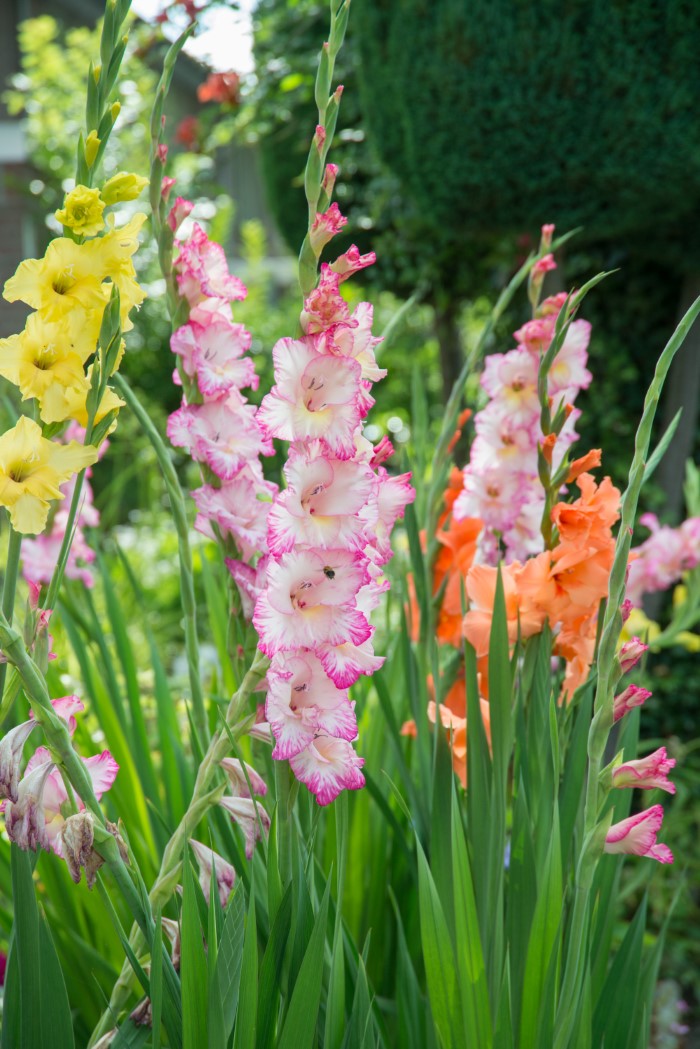Are Gladiolus a Perennial or Annual? Discover the Truth About These Beautiful Blooms

Gladiolus, with their stunning flower spikes and vibrant colors, are a favorite among gardeners and floral enthusiasts alike. However, there is often confusion about whether these striking blooms are perennial or annual plants. Understanding their lifecycle is essential for proper care and cultivation. In this article, we will explore the characteristics of gladiolus, clarify their growth habits, and provide insights on how to ensure these beautiful flowers thrive in your garden. Whether you’re a seasoned gardener or a novice, uncovering the truth about gladiolus will help you appreciate their beauty even more.
Are Gladiolus Perennials or Annuals?
Gladiolus are primarily classified as perennial plants, meaning they can live for more than two years under the right conditions. Although they are often grown as annuals in many gardens due to their sensitivity to frost, they can thrive as perennials in warmer climates. Gladiolus produce corms, which act as underground storage organs, allowing them to store nutrients and energy for regrowth every growing season. If left undisturbed and provided with suitable care, gladiolus can return year after year, producing beautiful flowers that add vibrant colors to garden landscapes.
Characteristics of Gladiolus
Gladiolus plants are known for their tall spikes adorned with various colorful flowers that bloom sequentially from the bottom to the top. They typically range in height from 2 to 4 feet depending on the variety. Their elongated leaves grow from the base, providing a lush backdrop for their stunning blooms. Gladiolus are often used in floral arrangements due to their elegant appearance.
Growing Gladiolus as Annuals
Many gardeners choose to grow gladiolus as annuals because they are sensitive to cold temperatures. In areas with harsh winters, these plants can be dug up and stored indoors to protect the corms from frost. Planting them each spring allows for a fresh bloom throughout the summer months, providing a quick and colorful spectacle in the garden.
Growing Gladiolus as Perennials
In hardy zones, gladiolus can be grown as perennials, allowing their corms to remain in the ground year after year. This method requires minimal maintenance, as long as the corms are well-drained to prevent rot. Perennial gladiolus will naturally rebound each season, providing a stunning display of colors without the need for replanting each year.
Climate and Soil Considerations
The ability of gladiolus to act as perennials or annuals often depends on the climate and soil conditions of the garden. They prefer well-drained soil rich in organic matter and thrive in full sunlight. Areas with mild winters allow corms to survive underground, while cooler climates often require gardeners to lift and store the corms until spring.
Table of Gladiolus Varieties
| Variety | Type | Height (ft) | Bloom Time |
|---|---|---|---|
| Gladiolus hortulanus | Perennial | 3-4 | Summer |
| Gladiolus primulinus | Annual | 2-3 | Late Summer |
| Gladiolus tristis | Perennial | 2-3 | Late Summer |
| Gladiolus dalenii | Perennial | 2-4 | Summer |
| Gladiolus hortulanus hybrids | Annual | 3-4 | Summer |
What do I do with gladiolus after they have flowered?

After gladiolus have flowered, it is essential to take the right steps to ensure their health for future blooms. Here’s what you should do with gladiolus after they have finished flowering:
1. Cutting the Stems: Once the gladiolus flowers have wilted and the petals begin to drop, cut the stem down to about 2 inches above the ground. This helps the plant focus nutrients on the bulbs rather than seed production.
See also:
2. Leave the Foliage: It's important to leave the foliage intact for several weeks after flowering. The leaves will continue to photosynthesize and provide energy to the bulb for next season's growth. You should allow the leaves to remain until they turn yellow and begin to die back.
3. Watering Needs: Maintain proper watering during the post-flowering period. Ensure the soil remains moist but not soggy. Adequate moisture helps the bulbs store necessary nutrients for the next blooming cycle.
4. Fertilization: After flowering, it can be beneficial to apply a balanced fertilizer to encourage bulb development. Use a liquid fertilizer that is high in phosphorus to promote root and bulb health.
5. Digging & Storage (if necessary): In regions with colder winters, it’s essential to dig up the bulbs once the foliage has completely died back. Gently lift the bulbs and let them dry in a cool, shaded area. Store them in a breathable container, such as a mesh bag, in a cool, dry place until the next planting season.
Understanding Gladiolus Lifecycle
The lifecycle of gladiolus includes several stages, from planting the corms to flowering and ultimately, the dormancy phase. Understanding this lifecycle will help in managing their care effectively.
- Planting the corms in spring after the last frost.
- Emergence of leaves and stems as the plant grows during the warm season.
- Development of flowers followed by the maturity of the bulbs.
Proper Timing for Cutting
Timing is essential when cutting back gladiolus after they have bloomed. It's best to wait until all flowers have faded completely. Cutting too early may hinder the plant's ability to store energy.
- Wait for flowers to wilt and dry out.
- Cut stems to about 2 inches above ground.
- Monitor the foliage for yellowing before removal.
Post-Bloom Care of Foliage
The foliage of gladiolus plays a crucial role even after flowering. By addressing the needs of the leaves, you can significantly impact the strength of future blooms.
- Allow leaves to remain until they turn yellow.
- Ensure they are adequately watered to support photosynthesis.
- Avoid cutting foliage until fully dying back.
Importance of Fertilization
Integrating fertilizer into your post-bloom care can significantly affect the health of the bulbs for next season. Proper fertilization techniques will promote robust growth.
- Select a balanced fertilizer suitable for flowers.
- Focus on applications high in phosphorus for bulb strength.
- Follow the manufacturer’s instructions for application frequency.
Storing Gladiolus Bulbs
Proper storage of gladiolus bulbs is vital, especially for those in climates that experience freezing temperatures. Secure storage allows you to preserve them until the next planting season.
See also:
- Dig up bulbs after foliage has completely died back.
- Allow them to dry out in a shaded area.
- Store in a cool, dry place in breathable containers.
Do gladioli multiply every year?

Gladioli, known for their tall spikes of flowers and wide range of colors, do not generally multiply every year in the same way some other perennials do. Instead, they are grown as bulbs, which are planted each season. These bulbs can produce multiple corms over time, leading to more plants, but this process requires specific care and conditions.
Understanding Gladiolus Bulbs
Gladioli grow from corms, which are a type of bulb. Each corm can produce new corms, thereby creating new plants. This process involves the corms storing nutrients and energy which makes it possible for them to multiply.
- Corm Structure: Each corm is a fleshy storage organ that contains the energy necessary for growth.
- Propagation: As the parent corm grows, it produces daughter corms that can be harvested and replanted.
- Flowering Cycle: Each season, the corms will flower, and after blooming, they can produce new offsets for the next season.
Replanting Gladiolus
Gladioli require a specific care routine to multiply effectively. Typically, the corms need to be dug up and stored after the growing season. They will not survive winter in cold climates and thus need replanting each spring.
- Storage Conditions: After blooming, corms must be dried and stored in a cool, dry place to prevent rot.
- Replanting Time: Corms should be replanted in the spring when the risk of frost has passed.
- Soil Considerations: Using well-draining soil is crucial for preventing issues like rot during replanting.
Factors Influencing Multiplication
Several factors influence the successful multiplication of gladioli. Understanding these can help gardeners enhance their yield and flowering quality.
- Soil Quality: Nutrient-rich, well-drained soil promotes healthy corm production.
- Watering Practices: Adequate watering during the growing season is essential, but overwatering can lead to diseases.
- Sunlight Attraction: Gladioli thrive in a sunny location, making it important to select proper planting spots.
Seasonal Care for Gladioli
Annual care for gladioli can significantly impact their ability to multiply and thrive. Seasonal tasks include planting, watering, and preparing them for dormancy.
- Spring Planting: Ensure corms are planted at the right depth (around 4-6 inches) during spring.
- Mid-Summer Maintenance: Regularly remove spent flowers and provide adequate water during dry spells.
- Fall Preparation: Before the first frost, dig up the corms to prepare them for storage during winter.
Common Challenges in Gladiolus Multiplication
Various challenges can affect the multiplication of gladioli, making it important for gardeners to be aware of potential issues.
- Pest Infestation: Gladioli can fall victim to pests like aphids and thrips, which can hinder growth.
- Diseases: Issues such as corm rot and fungal infections can compromise plant health.
- Environmental Factors: Extreme temperatures can affect the growth of corms and their ability to propagate.
Questions from Our Readers
Are gladiolus annuals or perennials?
Gladiolus are generally considered annuals in many climates, particularly in colder regions where they do not survive the winter. However, in warmer climates, they can act as perennials if the corms are well-maintained and not exposed to frost.
Can gladiolus corms survive winter?
In regions with harsh winters, gladiolus corms typically do not survive if left in the ground, as they are not frost-tolerant. It is advisable to dig up the corms and store them in a cool, dry place until spring.
See also:
How to care for gladiolus as perennials?
To care for gladiolus as perennials, plant the corms in well-drained soil and ensure they are watered appropriately during the growing season. In addition, applying a balanced fertilizer can promote healthy growth and blooming.
When do gladiolus typically bloom?
Gladiolus usually bloom in the summer, typically from mid-summer to early fall, depending on the planting time and the specific variety. The spikes produce stunning flowers, enhancing garden aesthetics during these months.

If you want to read more articles like Are Gladiolus a Perennial or Annual? Discover the Truth About These Beautiful Blooms, we recommend you check out our Flowers category.
Leave a Reply
Related Articles